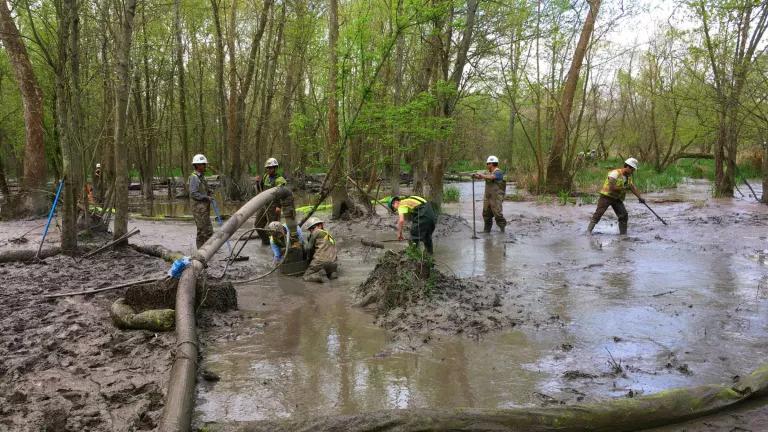Following Spills, Ohio Wants to Reroute the Rover Pipeline but Lacks the Muscle
High-profile disasters on the controversial pipeline prompted the feds to temporarily halt construction, but the state demands a more permanent solution.

Cleanup effort of the Rover Pipeline spill in Stark County, Ohio
Workers dressed in army-green chest-high waders fanned out into a northeast Ohio wetland last April and laid down a containment boom to trap a thick blanket of gray mud. Using an industrial-size hose, they vacuumed up the viscous sludge known as bentonite slurry, a mixture of water and clay used to lubricate drills. The concoction bubbled to the surface when Texas-based Energy Transfer Partners dug an underground borehole for its interstate Rover Pipeline, a 713-mile conduit that will transport natural gas from West Virginia and western Pennsylvania to distribution hubs in Ohio and Michigan.
At this section of the pipeline, an Energy Transfer crew was using horizontal directional drilling—a technique intended to cause less landscape disruption than traditional trenching—to burrow underneath the Tuscarawas River and adjacent wetlands. But as the drill bit cut through earth under high pressure, cracks formed and an estimated two million gallons of drilling fluid escaped to the surface. The diesel-tainted mud coated half a million square feet of the protected Stark County wetland, asphyxiating an untold number of plants, amphibians, and other aquatic life.
The disastrous spill was not the first for Energy Transfer, and not the last. Since construction began on the Rover Pipeline last March, the company has racked up at least 104 reported incidents, ranging from razing a historic house to spilling drilling fluid near drinking water wells. Ohio’s Environmental Protection Agency issued fines of more than $2.3 million to the company for violating air and water regulations, but Energy Transfer, claiming exemption from state regulation, has refused to pay. The Federal Energy Regulatory Commission (FERC) halted construction at the site last May while Energy Transfer drew up new plans for dealing with environmental concerns. Work resumed in September.
Vowing to finish the pipeline in the first quarter of 2018, Energy Transfer pressed on with drilling until January, when disaster struck again: Another 150,000 gallons of bentonite slurry disappeared down a borehole in the same Ohio wetland. State regulators called on FERC to halt the drilling there, and once again FERC complied.
Damage to wetlands is particularly serious in Ohio because there aren’t many left. The state is home to just 10 percent of the wetlands it once had, says Mark Dilley, president of the Ohio Wetlands Association. The state should do everything it can, he adds, to protect what’s left instead of endangering the plants and animals that live there. It will likely take years for the area to recover from the bentonite spill, and the cleanup process itself comes with its own issues, including damage from equipment, hoses, and boots, says Dilley.

Then there’s Energy Transfer’s environmental track record, which doesn’t exactly inspire confidence. The same company built the infamous Dakota Access Pipeline, whose construction sparked months of protests in North Dakota two years ago. That pipeline has leaked five times since it began operating in 2017. And the Rover Pipeline itself has received more negative inspection reports than any other major interstate natural gas pipeline built in the past two years, according to Bloomberg.
In a recent letter to FERC, Ohio EPA director Craig Butler wrote that “Ohio cannot support” the Energy Transfer environmental protection plan because it provides only temporary solutions to pipeline leaks and proposes ways to minimize drilling fluid losses rather than ways to prevent them in the first place. The state regulators, who lack the authority to block the pipeline, have urged FERC to require the company to reroute the second of the two pipes it is digging under the river and wetlands, or to make do with the one already in place. An Energy Transfer spokesperson says the company is in compliance with the approved plans and has completed 99 percent of the Rover Pipeline.
Dilley, who works as a consultant with energy companies, maintains that some areas of the state should nevertheless remain off-limits, including those with high-quality wetlands. “As a society we need to think about what our comfort level is with these sorts of risks,” he says. “Some of the routing decisions should factor in public opinion and knowledge of aquatic resources around those routes. There might be sensitive areas that should be avoided at all costs.”
If not, those sites may be crawling with cleaning crews in the future, too.
This NRDC.org story is available for online republication by news media outlets or nonprofits under these conditions: The writer(s) must be credited with a byline; you must note prominently that the story was originally published by NRDC.org and link to the original; the story cannot be edited (beyond simple things such as grammar); you can’t resell the story in any form or grant republishing rights to other outlets; you can’t republish our material wholesale or automatically—you need to select stories individually; you can’t republish the photos or graphics on our site without specific permission; you should drop us a note to let us know when you’ve used one of our stories.

Ohio Gains Ground on a Hidden Hazard: More Than a Century’s Worth of Abandoned Oil and Gas Wells
The Uinta Basin Railway Would Be a Bigger Carbon Bomb Than Willow
Water Is Life—from Standing Rock to Oaxaca’s Mixtecan Highlands